Colored belts that signify the wearer’s rank have been synonymous with martial arts since Jigoro Kano first introduced them to judo in the early 20th century. The concept is so popular that it has been adopted to show and reward progress even in areas outside of martial arts. BJJ also uses a colored belt system to rank its practitioners in a hierarchy.
The BJJ belt system is an integral part of the martial art. It is one of the stricter systems, awarding new belts only after long periods of dedicated training and proven skills. The belts for adults are white, blue, purple, brown, and black, followed by red and coral belts reserved for grandmasters.
Once you spend enough time on the mats, you will learn when and how you can earn new ranks in BJJ, but it’s a good idea to know what road lies ahead, which is what this comprehensive guide is for.
The Journey From White Belt To Black Belt
Progress is what keeps you motivated and invested in your endeavors. Having a tangible way to measure progress is the best option, which is why colored belts are so popular in martial arts. There is a truly special feeling of achievement when you are finally awarded a new belt after years of training and hard work.
Some martial arts have watered down their graduation system in the same way they have watered down their techniques and competitions. It’s not uncommon to see 13 old kids wearing black belts in some styles of karate or earning some new colored belts multiple times a year.
Thankfully, BJJ hasn’t yet fallen prey to this tendency, and earning a new belt on the mats does not come easy. The black belt “end goal” often comes only after 10 years on the mats, save for the few fiercely talented grapplers dominating competitions. This means the average person will spend years at each belt, making each promotion a significant event in their journey.
The instructor and academy decide the moment of promotion. There are some official guidelines from the IBJJF, but they concern the time you must spend in each rank and the age you must be to be eligible for a promotion. There are no set skills and moves you should know at each rank.
You will be promoted to the next rank when you show technical and tactical knowledge that the instructor believes is enough. BJJ has always been about practicality, so formal testing of dry technique is not a thing. Success in competition and executing techniques while rolling is what matters for progression.
BJJ Belt Levels For Adults
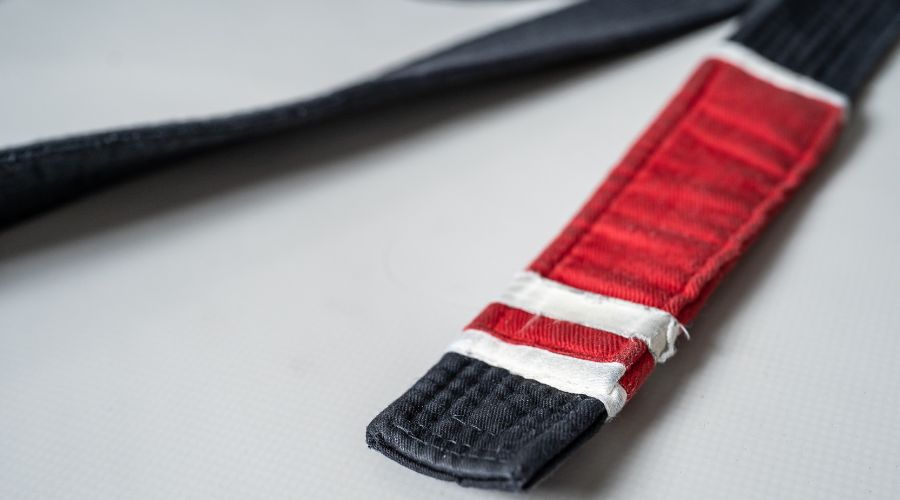
There are just five belt levels in BJJ for adults. These are:
- White
- Blue
- Purple
- Brown
- Black
Everyone starts with the white belt, and it is the only one that is handed out without any requirements. The end goal of most practitioners is to one-day wear the black belt, but very few reach this goal.
Many academies also use stripes for each belt color up to black to break down the process of going from one belt to the other. A total of 4 stripes can be earned, showing progress within that belt. Still, this practice is not universal across organizations and academies.
Once you reach black belt, the stripes become degrees, very similar to the dan system in karate and judo. Then finally, there are the coral belts and red belts, which are awarded only to masters with very significant merits, skills, and decades in the martial art.
BJJ Belt Levels For Kids
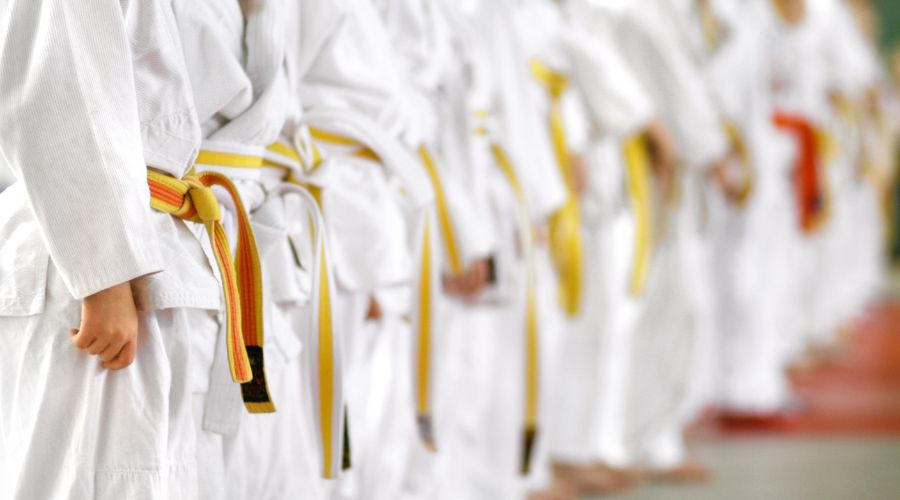
The requirement for a blue belt is for the practitioner to be at least 16 years of age, so there is another system for kids to progress into and not stay a white belt for many years. This system is valid for kids aged 4 to 15.
For each belt after white belt, students are awarded three different versions of each colored belt: first, a colored belt with a white horizontal bar, then a solid-colored belt, and finally, a colored belt with a black horizontal bar. The instructors award these based on the kid’s performance and behavior in the gym and competitions.
Here is the full order of the kid’s progression system in BJJ:
- White
- Grey/white
- Solid grey
- Grey/black
- Yellow/white
- Solid yellow
- Yellow/black
- Orange/white
- Solid orange
- Orange/black
- Green/white
- Solid green
- Green/black
What Are The Requirements For Each Belt Rank
The IBJJF, the largest governing body for Brazilian jiu-jitsu, imposes some time constraints, such as the age of practitioners and the minimum amount of time spent training at a rank before being eligible for promotion. The IBJJF observes these times between belts in competition.
Aside from that, there are no hard and fast rules about what each belt should be capable of doing and knowing. Still, there are many widely held beliefs, which we will go over for each belt color.
White
Level: Beginner
Minimum age: None
Minimum time before next rank: 1 year
Stripes: 4
The white belt is the only one handed to you, and there are no requirements to have it. As a white belt, your focus should be familiarizing yourself with the basic positions and movements. Most people quit at white belt, and survival in the gym and in each session is the primary goal.
Your ego will be crushed, as smaller and weaker people will constantly submit you. This is the essence of BJJ. Maintaining position and escaping from bad ones are the best things you will learn at this level, alongside all the mental things you will go through. If you persevere through this stage, you will be on the other side before you know it.
Blue

Level: Intermediate
Minimum age: 16+
Minimum time before next rank: 2 years
Stripes: 4
Most people receive their blue belt after two years of solid, consistent practice, and you must be at least 16 years old. At the blue belt level, you will obtain the most knowledge quantity-wise.
At this point, you should also be capable of tapping out untrained people easily, even if they are bigger. You should have a solid defense in all positions and at least a few reliable ways of passing guard by the time you graduate from blue belt.
Purple
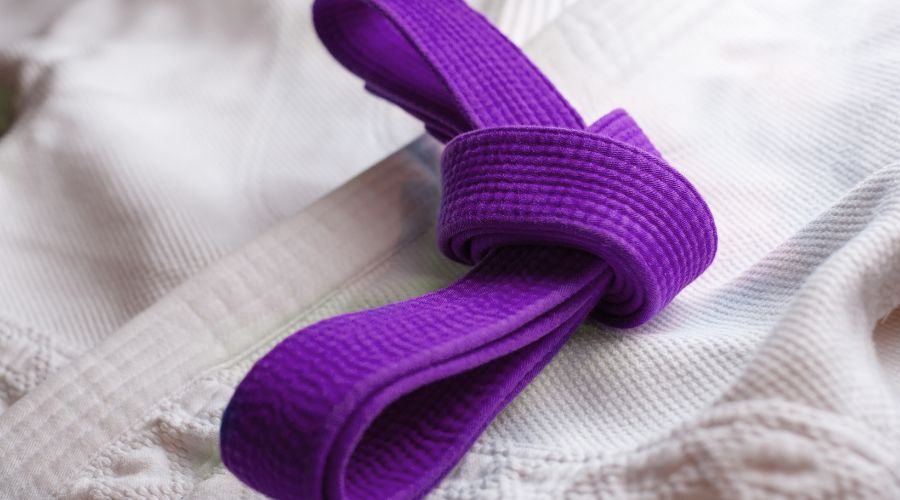
Level: Advanced
Minimum age: 16+
Minimum time before next rank: 1.5 years
Stripes: 4
After spending two years as a blue belt, you can get promoted to the first rank, considered advanced-purple. A purple belt can become an instructor for white belts and should handle regular blue belts easily.
At this point, you know enough to start developing your own style by focusing on techniques and concepts that come more naturally to you than others. A purple belt should also have reliable submissions from each guard position.
Brown
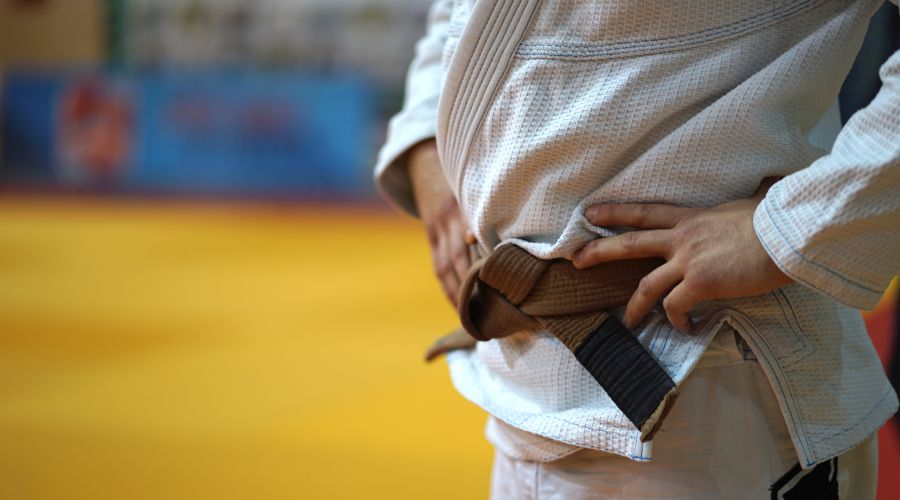
Level: Expert
Minimum age: 17+
Minimum time before next rank: 1 year
Stripes: 4
After a year and a half of solid training and competition as a purple belt, you may enter the ranks of brown belts. As such, you are considered an expert grappler, familiar with all scenarios and submissions. Competition at brown belt under the IBJJF becomes more dangerous with the addition of heel hooks and knee reaping.
Still, if you have dedicated yourself to reaching brown belt in the first place, this likely won’t be an issue. Brown belts are also experienced enough to be instructors, and many classes are run by brown belts when no black belts are present.
Black
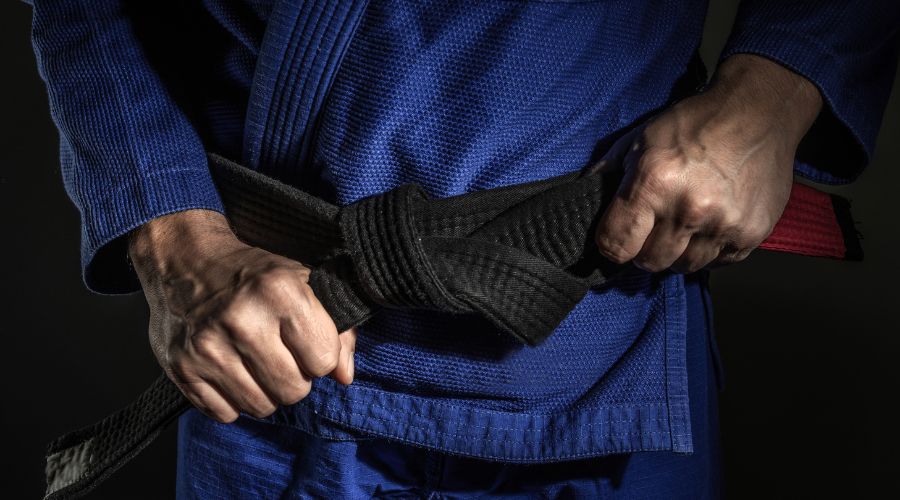
Level: Expert
Minimum age: 19
Minimum time before next rank: 3 years for degrees 1 to 3, 5 years for 4,5, and 6.
Stripes: 6
The black belt is a master of jiu-jitsu. The BJJ black belt is a dangerous martial artist on the mats and in real life. Most people take ten years to achieve their first-degree black belt, though this time can be much shorter in some cases. You must also have exemplary behavior and morals to be awarded a black belt.
The BJJ black belt is one of the few martial artists that you can be certain has been battle proven and meets all the criteria you associate with the degree, both in technical proficiency and behavior.
Are There Belts in No-Gi BJJ?
A No Gi competitor cannot wear a belt while competing, but they are still awarded belt ranks. Because many practitioners train in Gi and No Gi, it still applies to the No Gi version when they receive a belt. The IBJJF ranks No GI competitors based on their gi belt rank. But some academies are purely No Gi, and athletes may still receive belts, but this is not generally the norm.
Handling belts in no-gi is still a controversial topic. Some believe that no-gi has become its own entity and deserves its own ranking system independent of the gi version. Others frown at the notion and insist many concepts of BJJ can be grasped only with the traditional uniform on.
Then some support the benefits of using the belt system for No-Gi BJJ, such as differentiating skill levels in training and competition, rewarding No-Gi BJJ students’ effort and dedication, and instilling the martial arts philosophy in its practitioners.
Do Belt Ranks Matter?
They do, and they don’t. The colored belts provide a tangible goal to achieve and are a satisfying, hard-earned prize. They provide structure and hierarchy. But they are not everything in BJJ, and obsessing over rank is unnecessary.
While belts give a good indication of the level of the practitioner, you can always look at the picture of Khabib Nurmagomedov with his white belt and understand that the belt does not show the complete picture.
Ultimately, belt promotions in jiu-jitsu are at the instructor’s discretion, which means two practitioners with the same belt color can have vastly different skill sets, which is a common criticism of the system.
But in any case, the belt color always means the person has spent a certain amount of time and dedication to the martial art and has met certain standards, which is a good thing in my book.
Summary
The famous saying is that a black belt is just a white belt that never quit. Even though the belt system in BJJ has no concrete standards for promotion, a high standard is held by all practitioners, which guarantees that each belt is well earned. There are five belt colors in BJJ, and promotion happens only after you’ve proven yourself worthy of it in the eyes of the instructors who can elevate you in rank.
